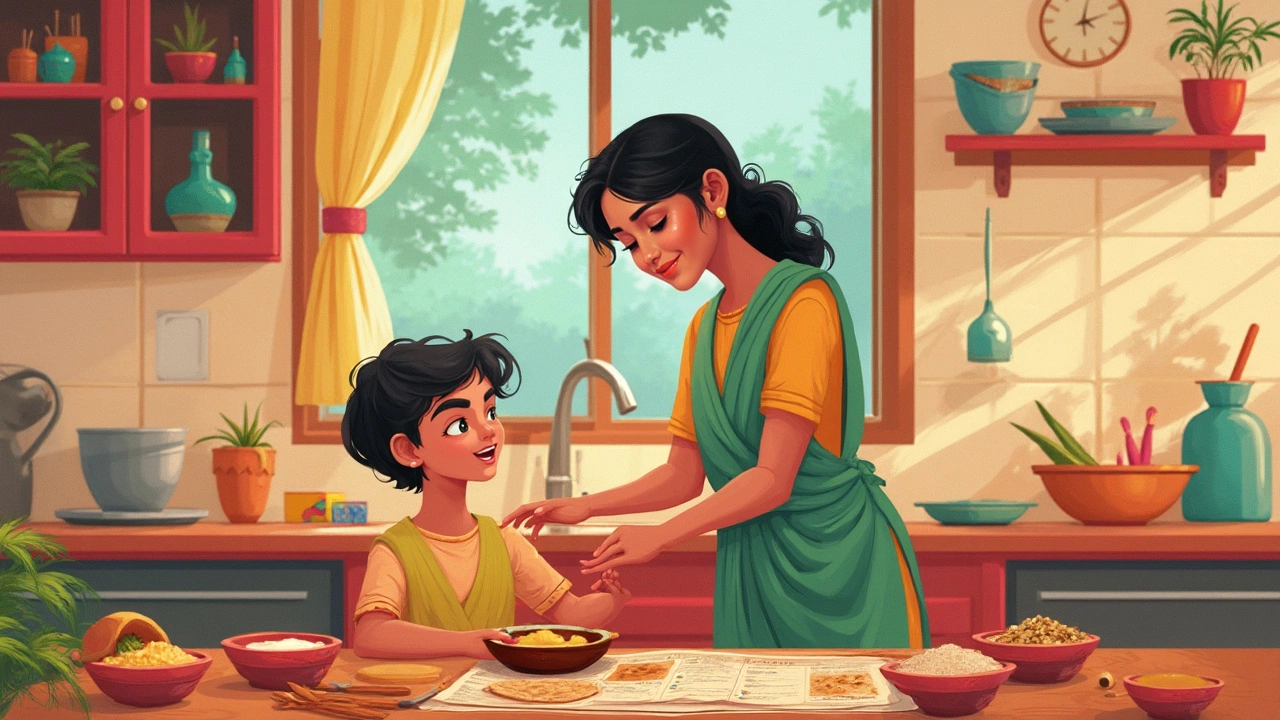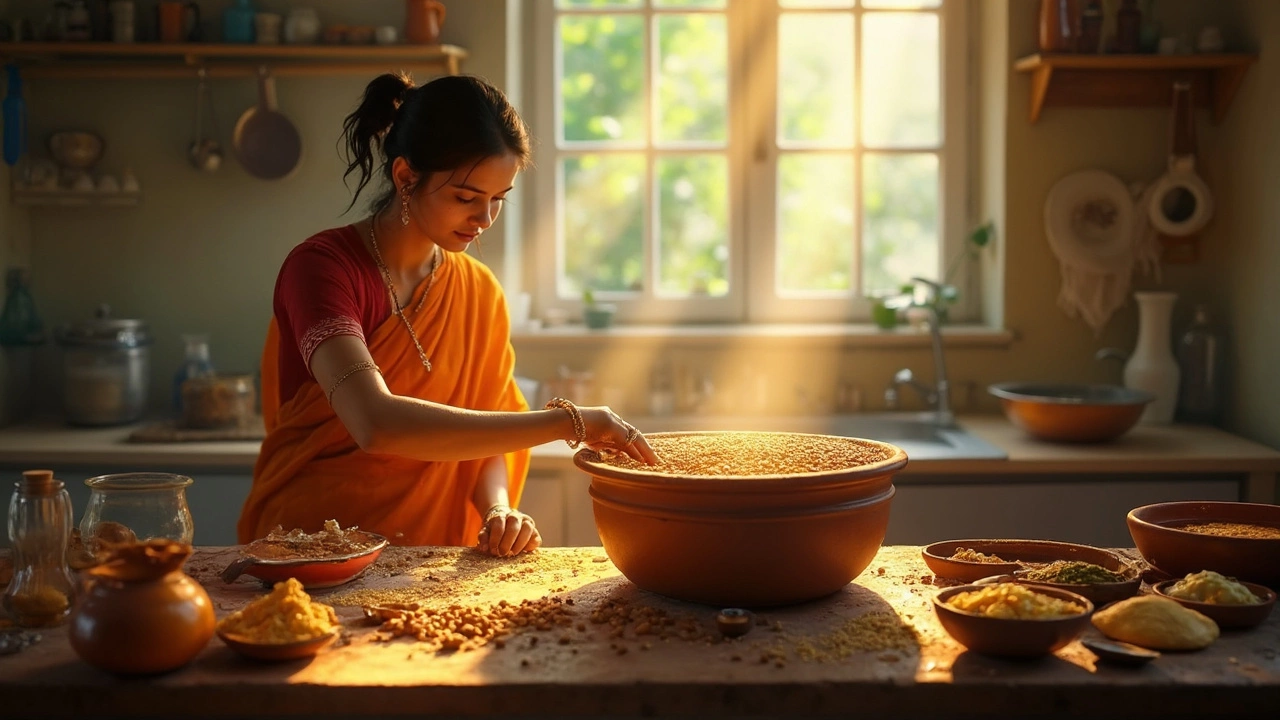14 Mar 2025
- 0 Comments
Soaking urad dal is a crucial step in making dosa batter that many first-time cooks might overlook. But just imagine: getting your dosa's texture just right with that perfect crispy, yet fluffy, consistency. It all begins with knowing how long to soak that tiny little bean.
Why does soaking matter? Well, it helps soften the dal, making it easier to grind, resulting in a smooth batter that's perfect for dosas. Plus, it activates enzymes that boost the fermentation process, giving your dosa its essential tangy flavor. Pretty neat, right?
So, how long do you really need to soak urad dal? Generally, around 4 to 6 hours should do the trick. This is ample time for the dal to absorb water and soften up nicely. But hang on, there’s more to it than just the clock watching. Temperature, water quality, and even the type of dal can impact soaking time.
- The Basics of Soaking Urad Dal
- Why Soaking Time Matters
- Ideal Soaking Duration
- Tips for Soaking Success
- Common Mistakes to Avoid
- Secrets from Experienced Cooks
The Basics of Soaking Urad Dal
Soaking Urad Dal is kind of like the foundation for your dosa batter. If you get it right, you're setting yourself up for dosa success. But don't just toss it in water and forget about it. There's a bit of a science to it.
First things first, why soak at all? Soaking the dal softens it and makes it easier to grind into a smooth paste, which is exactly what we want for our fluffy dosas. Without soaking, you'd end up with a gritty batter that's hard to spread on a hot tawa. Nobody wants that.
Step-by-Step Soaking
- Start by rinsing the urad dal thoroughly. Think of it as a mini cleanse, getting rid of dirt or impurities.
- Next, put the dal in a deep bowl and cover it with plenty of water, almost double the volume of the dal.
- Let it sit for about 4 to 6 hours. This range is flexible; if it’s cold outside, you might need closer to 6 hours.
- Once soaked, you’ll see the dal plump up, and when you press it, it should feel soft.
As for the water you use, distilled or filtered water is ideal. Why? Minerals in hard water can sometimes mess with soaking and fermentation. Not a good thing if you want a perfect dosa batter.
Here's a fun tidbit—soaked dal can increase in volume by about 2.5 times its original size. Talk about fluffing up nicely!
What to Watch Out For
- Avoid over-soaking, as it can lead to fermentation starting right in the soaking bowl, which isn't great.
- If storing soaked dal, keep it in the refrigerator to pause the fermentation till you’re ready to grind it.
- Smell matters! If your soaked dal smells funky, toss it out and start fresh.
Why Soaking Time Matters
Understanding why soaking your urad dal is so important can truly make a difference in your dosa-making adventures. It's not just about the time; it's about what that time allows the dal to achieve. Soaking plays a huge role in the texture, taste, and digestibility of your dosas.
Texture and Grinding
We’ve all struggled with batter that’s just too hard to blend. Properly soaked dal softens significantly, making it a breeze to grind to the silky smooth consistency you need for dosas. When the dal isn’t soaked long enough, it can turn your grinding process into a bit of a nightmare. You'll be left with a batter that's gritty and lacks the airiness needed for a good dosa.
Fermentation and Flavor
The secret to authentic dosa is in its tangy flavor, which comes from fermentation. But fermentation can only happen right when your batter has the right balance of water content, ground effectively from soaked dal. Soaking your urad dal properly activates enzymes that enhance fermentation, giving your batter the tang it needs.
Table: Benefits of Proper Soaking
| Soaking Time | Benefits |
|---|---|
| 4-6 hours | Optimum texture, aids grinding, enhances fermentation |
| Less than 4 hours | Inadequate softening, poor grinding results |
| More than 6 hours | Potential mushiness, over-fermentation risk |
Digestibility
Not just about flavor and texture, soaking even boosts the health factor. Longer soaking reduces phytic acid in dal, which is known to interfere with the body's absorption of certain minerals. It ultimately makes your dosas easier on the stomach.
Ideal Soaking Duration
Most experts agree that soaking urad dal for dosa batter typically ranges from 4 to 6 hours. This duration is just right for hydrating the dal without it turning mushy. When the dal is soaked correctly, it grinds into a smooth paste, crucial for that perfect dosa texture.
Why 4 to 6 Hours?
Well, it's all about water absorption and enzyme activation. When urad dal absorbs water, it swells, making it easier to grind. The soaking also kick-starts some lovely enzymatic action that aids in fermentation, giving you dosas with a delightful tang.
Factors to Consider
- Temperature: Warmer climates might reduce the soaking time as the dal absorbs water more quickly.
- Water Quality: Use clean, preferably filtered water. Avoid hard water as it slows down the soaking process.
- Dal Type: Optical quality makes a difference! Opt for good quality urad dal for consistent soaking results.
Quick Tips
- Check the weather: If it's a hot day, you might need just about 4 hours.
- Test a grain: When you split a soaked dal grain, it should break easily under slight pressure.
- Skip the rush: Avoid shorter soaking times as it affects the batter's consistency.
Getting the soaking right is like food alchemy—it transforms that tiny grain into something magical, ready to be blended into a fine dosa batter that cooks up nice and crispy. Keep a close eye, follow these tips, and you'll nail it every time!

Tips for Soaking Success
So, you want to get the perfect soak for your Urad Dal? It’s simpler than you think! Here are some handy tips to make sure your dosa batter is top-notch.
1. Measure Right
Start with the right amount. For a classic dosa batter, typically use a ratio of 1:3 for urad dal to rice. This balance ensures the batter isn't too thick or too runny.
2. Quality Matters
Always choose good quality Urad Dal. Avoid dal that looks discolored or has a weird smell. Fresh dal absorbs water better, giving you a smoother batter.
3. Rinse Thoroughly
Before soaking, rinse the dal thoroughly. This not only cleans it but also helps remove excess starch that might affect the batter's texture.
4. Use Enough Water
Ensure the dal is fully submerged in water. Water level should be at least two inches above the dal. This ensures they all soak evenly.
5. Temperature Check
Room temperature water is usually best for soaking. However, if it's winter and chilly, consider using lukewarm water to help soften the dal faster.
6. Keep an Eye on Timing
Remember, soaking urad dal for about 4 to 6 hours is ideal. Set a timer to remind you! Over-soaking can make the dal mushy and affect fermentation.
For a quick recap, here's a handy checklist:
- Measure the dal and rice correctly.
- Choose fresh, quality dal.
- Rinse the dal well before soaking.
- Make sure water fully covers the dal.
- Use room temperature or lukewarm water.
- Don’t forget to time the soak!
Armed with these tips, you’re well on your way to dosa perfection. Happy cooking!
Common Mistakes to Avoid
Making dosa batter isn't rocket science, but a few common missteps can lead to less-than-perfect dosa every time. Let's put the lid on these mistakes, shall we?
Using the Wrong Soaking Time
One of the biggest blunders is not paying attention to how long you soak your Urad Dal. Too short, and the dal won’t grind smoothly. Too long, and it loses its oomph, affecting the dosa's texture. Stick to the 4 to 6-hour window for best results.
Poor Water Quality
Believe it or not, the type of water you use matters. Hard water can mess with the fermentation process, jeopardizing that signature dosa tang. Use filtered or soft water to keep things on track!
Ignoring Temperature
If the kitchen’s too cold, your batter won’t ferment properly and could end up flat-tasting. In cooler months or climates, consider keeping the batter near a warm spot, like an oven with just the light on.
Overcrowding the Grinder
Piling in too much dal into the grinder can lead to uneven grinding. Make sure to work in batches if needed, giving each bit the space to turn into a smooth paste.
Skipping the Rinse
Always rinse the soaked dal thoroughly before grinding. This helps to wash off any excess starch, contributing to a lighter batter texture. Nobody wants gummy dosas, right?
Imbalanced Ratios
Another classic mistake? Messing up the rice-to-dal ratio. Generally, a 3:1 ratio works well, ensuring the dosa is crispy yet balanced in flavor.
| Mistake | Impact |
|---|---|
| Incorrect Soaking Time | Impacts texture |
| Hard Water Usage | Affects fermentation |
| Overcrowding Grinder | Leads to uneven grinding |
Secrets from Experienced Cooks
When it comes to crafting that unforgettable dosa, many experienced cooks have their own little tricks up their sleeves. One thing they've all got in common? Mastery over soaking Urad Dal.
Experienced chefs often swear by soaking the dal overnight when the weather's cooler. They claim that a good 8 to 10-hour soak during winter months ensures the dal softens just right. During the warm summer days, sticking to a 4 to 6-hour soak is usually enough.
Use the Right Water Temperature
One secret lies in the water temperature. Using lukewarm water for soaking can speed up the process and offers a more consistent result. Just make sure not to use hot water—it may over-soak the dal, leading to a sticky batter.
Adding Fenugreek Seeds
Another popular tip is tossing in a pinch of fenugreek seeds while soaking. It aids in fermentation, enhances the dosa batter's flavor, and gives it that delicate golden color when cooked.
Don’t Overlook Quality
Lastly, choosing good quality urad dal matters a lot. Old dal takes longer to soak and never grinds as well as fresh. Dosa recipe veterans will often use organic dal for its unmatched taste and texture.
The blend of meticulous soaking and these tried-and-true secrets is what elevates your dosa from decent to delectable. Maybe it’s time to channel your inner chef and give these tips a shot!
